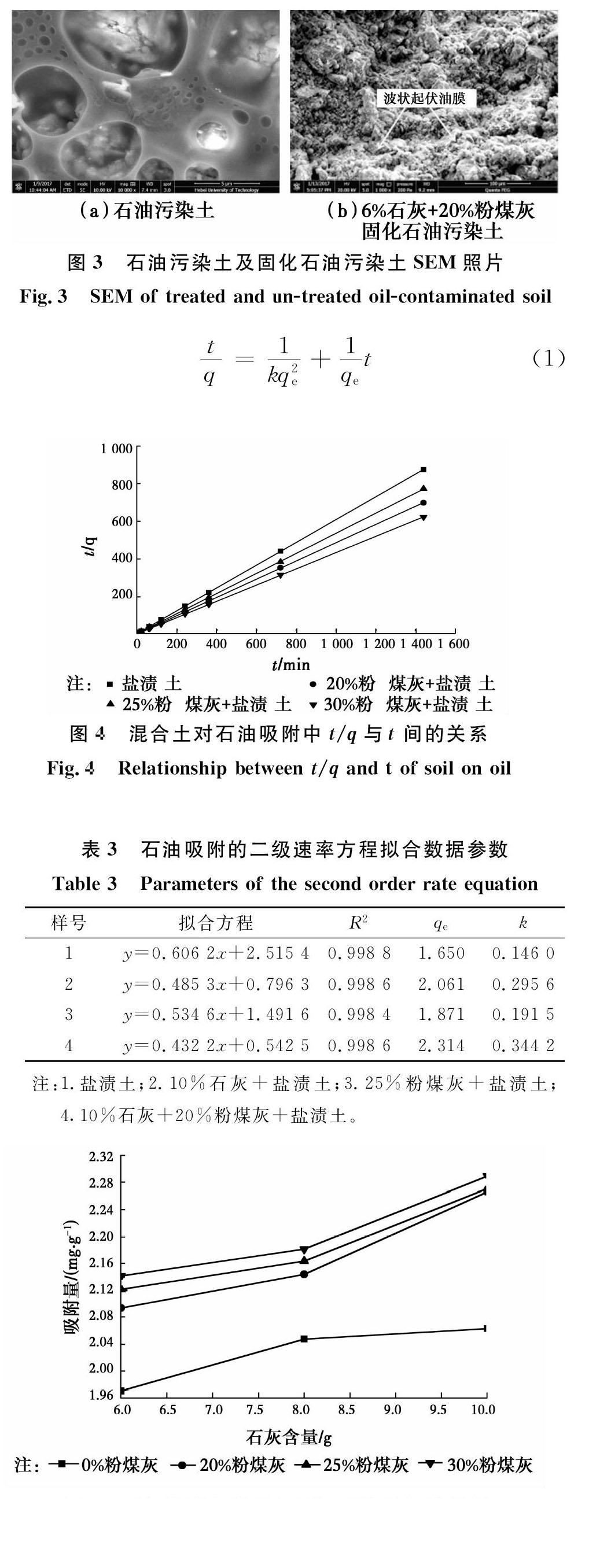石灰、粉煤灰改性对盐渍土吸附石油污染物行为的影响
2019-06-10李敏董一凡上官中华秦向鹏
李敏 董一凡 上官中华 秦向鹏



摘 要:有效调控污染物的运移是实现污染土工程再利用的前提。考虑石油污染盐渍土的特殊性及工程利用的力学需求,优选石灰和粉煤灰为改性材料,结合静态动态试验,研究石灰和粉煤灰对滨海盐渍土中石油污染物的吸附解吸行为的影响。结果表明:单独的石灰和粉煤灰,对石油污染物的吸附率分别为26%和14%,两者联合作用时,吸附率提高到39%,在盐渍土中加入石灰和粉煤灰可有效提高对石油污染物的吸附量,加快吸附稳定速率;盐渍土、石灰+盐渍土、粉煤灰+盐渍土、石灰+粉煤灰+盐渍土对石油的吸附动力学均符合Lagergren二级动力学非线性方程,联合作用可使吸附平衡时间由400 min缩短至60 min;石灰、粉煤灰有利于吸附赋存于土颗粒孔隙中未被盐渍土颗粒吸附的呈自由态的石油;盐渍土、石灰+盐渍土、粉煤灰+盐渍土、石灰+粉煤灰+盐渍土对石油污染物的吸附等温线均为非线性Freundlich模式;石油被解吸的能力依次为盐渍土>粉煤灰+盐渍土>石灰+盐渍土>石灰+粉煤灰+盐渍土,石灰+粉煤灰对石油污染物的吸附以化学吸附为主,具有不可逆性,有助于缓解环境温度的影响,增强稳定性。
关键词:石油污染土;吸附解吸动力学;吸附热力学;石灰;粉煤灰
中图分类号:TU448
文献标志码:A 文章编号:2096-6717(2019)02-0053-07
Abstract:Control of pollutant migration is the prerequisite for the reuse of contaminated soil. Considering the properties of contaminated saline soil and the mechanical demand in engineering utilization, lime and fly ash were chosen optimally as treated materials. The influence of lime and fly ash on adsorption-desorption behaviors of oil contamination in inshore saline soil were studied via static and dynamic tests. Results indicate that: under the individual action of lime and fly ash, the oil adsorption rate is increased by 26% and 14%, respectively, and it increases by 39% as combine. As a conclusion, lime and fly ash can effectively increase adsorption rate and improve adsorption rate of oil contamination. Adsorption kinetics of saline soil, lime + saline soil, fly ash + saline soil, lime + fly ash + saline soil on oil contamination conform to the dynamic nonlinear equation of Lagergren second-level dynamics. The adsorption equilibrium time of saline soil was 400 min and it reduced to 60 min for lime and fly ash. Lime and fly ash is beneficial to adsorb the free oil which cannot be adsorbed by saline soil. The adsorption isotherms of saline soil, lime + saline soil, fly ash + saline soil, lime + fly ash + saline soil are non-linear Freundlich models. Adsorption of oil contamination for lime + fly ash is an irreversible chemical process , which can help to reduce the influence of ambient temperature and enhance stability.
Keywords:oil contamination soil; adsorption-desorption kinetics; adsorption thermodynamics; lime; fly ash
石油作為一种含有多种烃类及少量其他有机物的复杂混合物,存在致癌、致畸、致突变的风险[1]。石油污染土体后,一部分被土颗粒中的矿物质和有机质吸附,另一部分则会在水动力的驱动下,继续向土体内部迁移,造成大面积的土体污染[2-4]。被土颗粒吸附的石油具有不稳定性,温度、含水率等因素的变化均会使被土颗粒吸附的石油重新发生解吸,成为二次污染源[5-6]。改性固化以实现其工程再利用是污染土的处置理念之一[7],有效控制土中污染物的迁移是需解决的关键问题[8-9]。
针对土体与石油间吸附性的研究集中于非盐渍土:水中细小的油微粒在黄土表面上的粘附速度很快,10 min即可基本达到平衡[10]。石油的吸附量与土壤粒径及pH值的大小成反比,并随土壤有机质含量的升高而增大[11]。由于蒙脱石比表面积较大,且含有部分金属离子,当土中加入蒙脱石等吸附剂进行改性后,对石油的吸附量有很大提高[12]。Linear吸附关系可描述原油在土体中的吸附状况,有机质含量会影响原油的吸附量[13];较高的介质盐度和较低的温度有利于重油在沉积物上的吸附,吸附速率方程可用伪二级动力学模型描述[14];高岭石对沥青质的吸附等温线符合Langmuir吸附等温式[15];多环芳烃类物质浓度为100~1 000 μg/L时,土体对芳烃类物质的吸附符合Freundlich等温吸附模型[16]。
